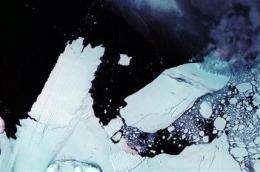Iceberg breaks in Antarctica not where expected

(AP) -- With the dramatic crash of an iceberg against a glacier that dislodged a massive new chunk of ice, the mysterious continent of Antarctica once again did the unexpected.
A big chunk of ice, slightly smaller than Oahu, broke off from a place it wasn't supposed to and in a way that wasn't quite anticipated, scientists reported Friday.
The new iceberg broke off from the cooler eastern end of Antarctica, the result of tidal forces that caused a longer but thinner iceberg that stretches for 60 miles to hammer it free. The new chunk broke off a long tongue of ice that had been building for decades, but will unlikely cause future ice loss problems on the continent, scientists said.
This happened as researchers have focused attention on the western side of Antactica, a continent about 1 1/2 times larger than the United States. Concern has grown over warmer temperatures there and especially the region's shrinking peninsula, which sticks out into the water like a broken pinky finger.
Remarkably, that peninsula, where last year one ice shelf was said to be hanging by a thread, has had an unusually cool summer. It's hit pause on ice loss, said Ted Scambos, senior scientist with the National Snow and Ice Data Center.
In a satellite phone interview this week from the western peninsula where he's working, Scambos predicted no major ice calving. His comments were made Thursday.
The next day Australian researchers alerted the world to the iceberg crash with the Mertz Glacier on the other side of the continent. They said it had probably occurred around Feb. 12 or 13.
"There are some crazy things going down in Antarctica," said Mark Serreze, director of the snow and ice data center, based in Boulder, Colo. "It seems kind of weird, but weird things happen."
Scientists have been tracking global warming's influence in Antarctica, a place more complicated than the Arctic. Scambos was placing instruments on the dwindling Larsen ice shelf in the peninsula to measure its disintegration in a scientific version of a deathwatch.
The ice loss that happened a couple of weeks ago was not due to global warming, but a natural process taking place in a region that has been relatively stable over the years.
For decades the tongue of the Mertz Glacier in the eastern part of the continent has grown further out into the water until it was about 60 miles long by 18 miles wide, said Benoit Legresy, a researcher with the LEGOS laboratory for geophysical studies in Toulouse, France.
Then an iceberg called B9B, which had broken off from another part of Antarctica in 1987, came by and "gave it a pretty big nudge," said Australian Antarctic Division glaciologist Neal Young.
"It was a slow process," Legresy said. He said B9B was "sitting there, it must have been pushed and pulled by the current every day and used as a hammer to bang on the other one by the ocean currents."
The dislodging occurred because of the iceberg's latest location and water that had warmed during Antarctica's summer, leaving less sea ice, Legresy said.
This happened "behind our backs," said NASA glaciologist Robert Bindschadler. "It's a good thing to be reminded that it's not all about west Antarctica."
Tongues like the one on the Mertz "ultimately are going to have to break off, making some big pieces of ice, and the ocean moves them around and occasionally they get in each other's way," Bindschadler said.
A couple scientists worried that this region around the Antarctic coast could fill with sea ice, which would disrupt the sinking ability of the dense and cold water. This sinking water is what spills into ocean basins and feeds the global ocean currents with oxygen, said Steve Rintoul, an oceanographer at Australia's national science agency. The fear is that it could starve areas of oxygen.
But other scientists from NASA, Penn State and the British Antarctic Survey said that's not a very likely scenario and not to worry.
"Icebergs whacking each other has happened for millions of years and life is still down there and pretty robust," NASA's Bindschandler said.
More than anything, it's a shift from the usual worries about Antarctic ice.
Data and new detailed maps from the U.S. Geological Survey, the British Survey and the snow and ice data center show that the western Antarctic peninsula has been shrinking noticeably. Since the first measurements were made more than 50 years ago, the peninsula has lost about 8,000 square miles of ice - slightly less than the size of New Jersey - said USGS scientist Jane Ferrigno. The peninsula itself is about the size of Montana.
And every ice shelf on that peninsula has shrunk, with the losses accelerating since the 1990s, Ferrigno said.
"It may be a red flag about what may be happening in the future if this warming continues," Ferrigno said. "This is way beyond anything we've seen before" in centuries of ice core data.
With that in mind, snow and ice data center's Scambos and a team of researchers put measuring devices all over the threatened Larsen ice shelf, where he said "it does look like it's an ice shelf that's really in its last years of existence."
But it won't disappear this year, he said.
Cooler-than-normal temperatures have paused the melt, Scambos said, a development he views as only temporary. "There's no big recovery in progress."
More information: The Antarctic Climate and Ecosystems' report on the Mertz Glacier break: http://tinyurl.com/mertzglacier
The U.S. Geological Survey's report and map on ice shelf loss: http://pubs.usgs.gov/imap/i-2600-c/
The National Snow and Ice Data Center's State of the Cyrosphere: http://nsidc.org/sotc/iceshelves.html
©2010 The Associated Press. All rights reserved. This material may not be published, broadcast, rewritten or redistributed.



















